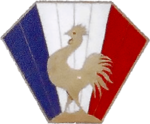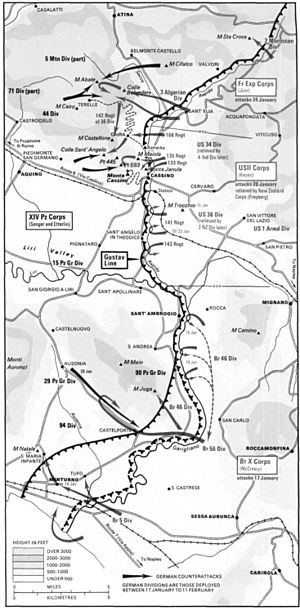French Expeditionary Corps (1943–44) facts for kids
Quick facts for kids French Expeditionary Corps |
|
|---|---|
| Corps Expéditionnaire Français | |

Shoulder sleeve insignia
|
|
| Active | 1943–1944 |
| Country | French Colonial Empire |
| Allegiance | |
| Type | Army |
| Size | 4 Divisions (112,000 men) |
| Engagements | World War II |
| Commanders | |
| Notable commanders |
General Alphonse Juin |
The French Expeditionary Corps (also known as the CEF) was a special group of soldiers from the French Liberation Army. It was formed in 1943 during World War II. This group fought in the Italian Campaign under the command of General Alphonse Juin.
The CEF had about 112,000 soldiers, divided into four main groups called divisions. Most of these soldiers were from French colonies, especially Moroccans and Algerians. They came from the Army of Africa and were led by French officers. About 60% of the corps was made up of these colonial troops. In August 1944, the corps left Italy. It then joined the French First Army to help invade Southern France in an event called Operation Dragoon.
Contents
How the Corps Started
After American forces landed in Algiers in 1942, many French colonial troops joined the fight. Before this, they were under the control of Vichy France, a French government that worked with the Nazis. General Charles de Gaulle, who led the French government that was fighting against the Nazis, used these soldiers to create the CEF.
The CEF was made up of two-thirds African soldiers from places like Morocco, Algeria, and Senegal. The other third were French settlers. In total, there were 112,000 men in four divisions. Many of the African soldiers grew up in the Atlas Mountains of North Africa. This made them very good at fighting in mountains, and they were the only Allied units with this special skill.
Some units were made only of Moroccan soldiers called goumiers. These soldiers came from the Riff mountains and were grouped into units called "tabors." There were 7,833 Moroccan Goumiers in total. Other North African units had local soldiers who volunteered or were drafted. They were recruited based on their tribe or region. Some non-French soldiers from the Foreign Legion also joined.
The CEF used Allied weapons like the Thompson submachine gun and the Browning machine gun. Moroccan soldiers also carried a traditional curved dagger called a koumia.
Who Led the Corps
The entire campaign in Italy was led by Lieutenant General Mark W. Clark from the U.S. Fifth Army. The commander of the French Expeditionary Corps was General Alphonse Juin. He later became a very important French military leader. General Juin himself was from Algeria and had spent much of his life leading Arab and Berber soldiers. General Marcel Carpentier helped him.
Other important officers included General Joseph de Goislard de Monsabert, General François Sevez, and General Augustin Guillaume. General Guillaume was in charge of the three Moroccan tabors, which were like large battalions.
Main Divisions of the Corps
The CEF had four main divisions:
- 1st Free French Division: This division arrived in Italy in April 1944. It included soldiers from the 13th Foreign Legion Demi-Brigade and other units.
- 2nd Moroccan Infantry Division: This division arrived in Italy in November 1943. It had several Moroccan infantry regiments.
- 3rd Algerian Infantry Division: This division arrived in Italy in December 1943. It included Algerian and Tunisian infantry regiments.
- 4th Moroccan Mountain Division: This division arrived in Italy in February 1944. It was specialized in mountain warfare.
There were also other groups, like the Moroccan Goumiers, who were very important.
Battles at Monte Cassino
The first CEF troops to fight were the 2nd Moroccan Division and the 4th GTM (a goumier unit). They arrived in January, followed by the 3rd Algerian Division. They were placed in the high mountains on the far right side of the U.S. Fifth Army.
Since they were used to mountain fighting, the CEF pushed back the German 5th Mountain Division. They captured Monte Belvedere and Colle Abate. However, they stopped before taking Monte Cifalco because they had many losses and needed more soldiers. The Allied leaders decided to pause and get ready for a new attack in May called "Diadem." More units joined, including the 1st French Motorized Division, the 4th Moroccan Mountain Division, and another goumier group (the 1st GTM).
The CEF was not involved in the next two smaller battles around Cassino town. But they played a big part in the fourth and final battle, which started on May 11, 1944. The Corps attacked the tough Aurunci Mountains. The Germans thought these mountains were impossible for soldiers to cross.
The CEF, especially the lightly equipped goumiers, made great progress. They captured Monte Maio and pushed deep into the Aurunci Mountains. This threatened the German forces fighting in the nearby Liri valley. Because of the CEF's advance, the Germans had to retreat. This allowed other Allied forces to move forward. On May 18, Polish soldiers captured the heights of Monte Cassino and the ruined abbey on top.
Breaking the Gustav Line
General Mark W. Clark wrote in his book that the CEF helped break through the strong German defense line, known as the Gustav Line, in May 1944.
The fighting for the Gustav Line was very hard for the CEF. They were in intense mountain battles. After this, while General Clark entered Rome, the CEF attacked east of the city. They secured the road to Siena and captured Siena itself. After the Italian campaign, the CEF soldiers returned to Africa. They then joined the Army B to take part in Operation Dragoon, which was the invasion of southern France.
Soldiers Lost
During the campaign, about 6,500 CEF soldiers were killed. Around 2,000 went missing, and 23,000 were wounded. The soldiers of the CEF who died are buried in French military cemeteries in Monte Mario (near Rome) and Venafro.
See also
- Army of Africa
- Liberation of France
- Marocchinate
- Moroccan Goumier



